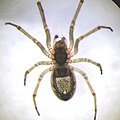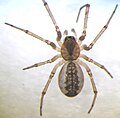Canopy spiders
| Canopy spiders | ||||||||||||
|---|---|---|---|---|---|---|---|---|---|---|---|---|

|
||||||||||||
| Systematics | ||||||||||||
|
||||||||||||
| Scientific name | ||||||||||||
| Linyphiidae | ||||||||||||
| Blackwall , 1859 |
The canopy spiders or blanket web spiders (Linyphiidae) are a family of real spiders (Araneomorphae) and belong to the superfamily of orb web spiders (Araneoideae). The family comprises 618 genera and 4667 species worldwide . (As of August 2020)
They are currently divided into six subfamilies. Approx. 500 species have been recorded in Central Europe.
features
These mostly only 1.5 to 3 mm large spiders are mostly only perceived in the morning dew by their webs, which they often weave near the ground in meadows or in the shrub layer, horizontally and slightly arched like a canopy. The threads with which they move in the wind in late summer and autumn are also striking; as well as the winter activity of some dwarf spiders (subfamily Erigoninae).
Way of life and catch of prey

The color of the canopy spiders camouflages them from their enemies when they hang under their horizontally stretched webs. The upward-facing belly side is darker in color and difficult to see against the floor. The back, on the other hand, is lighter in color, so that it also has little contrast against the light sky.
The canopy, in the middle of which the ceiling web spiders sit on the underside, is stretched from below by threads. The spiders pull sticky “falling threads” upwards, in which the prey is caught. The spider often shakes its prey from these threads onto the web below; the glue threads in the ceiling and in the fall threads do not play an equally important role in all categories. The spider then bites through the web with its chelicerae into the prey and stuns it. Finally, it bites a hole in the ceiling and drags its prey down for consumption through extraintestinal digestion . The damaged ceiling and falling threads are only repaired after eating.
The web of the canopy or ceiling web spiders shows distant similarities with the webs of the funnel spiders (Agelenidae), v. a. the labyrinth spiders ( Agalena ), which weave several blankets on top of one another, and with those of the ball spiders (hooded web spiders) (Theridiidae), which weave sticky, loosened and diffuse blankets. The lurking position of the canopy spiders is clearly distinguishable.
Sexually mature males rarely weave their own nets, but rather go in search of a female. Even longer after the mating, which lasted several hours, the male lives with the female in the same net, but tends to stay at the edge of the net.
Habitats and “airships” as a strategy of expansion
The family is spread around the world and inhabits very different habitats in all climatic zones, from the tropics (Congo: Labullula annulipes ) to beaches (in the seaweed), the Himalayas ( Piniphantes himalayensis ) and the arctic coasts. By far the most species-rich and widespread are the almost "omnipresent" genera Erigone , Bathyphantes , Leptyphantes and Walckenaeria (= Walckenaera ). Erigone atra and Bathyphantes gracilis are extremely common in Central Europe .
In contrast to other groups of spiders, in which only the juveniles can be carried away by the wind with the help of a "flying thread" in order to avoid competition and cannibalism by conspecifics when the population is too high , the adults in the Linyphiidae family also fly by the thousands from summer to winter, which is a successful strategy for dissemination. To do this, the spiders stretch their abdomen in the air and produce a so-called flight thread. If the thread is long enough, it will be caught by the wind and transport the spider. This process is called " airships " or " ballooning " in English . If the calm winter air warms up quickly above the ground due to the sun's rays, the spiders can be lifted up and transported. They are particularly noticeable in late summer (" Indian summer ") and in winter. They can occur en masse for a short time.
When transported through the air, canopy spiders reach heights of several thousand meters and fly up to several hundred kilometers. They were caught from airplanes and Charles Darwin reported in his diary in 1832 that 100 km off the coast of South America countless small spiders got caught in the rigging of his research vessel. It is now known that they can adjust the altitude and duration of flight through the length of their thread. However, very few survive their travels. Most end up on the water, in unsuitable habitats, or are eaten by birds. The British vernacular knows the air-transported spiders under the name money spider , which, if they land on you, is supposed to bring financial happiness ("weaving new clothes").
Systematics of the Linyphiidae
According to Andrei V. Tanasevitch, the family is currently divided into seven subfamilies:
- Dubiaraneinae ( Millidge , 1993) ; 87 species
- Erigoninae (Emerton , 1882) ; 2141 species
- Ipainae Saaristo , 2007 ; 26 species
- Linyphiinae (Blackwall , 1859) ; 819 species
- Micronetinae (Hull , 1920) ; 1113 species
- Mynogleninae (Lehtinen , 1967) ; 115 species
- Stemonyphantinae (Wunderlich , 1986) ; 14 species
Cladogram
|
|||||||||||||||||||||||||||||||
|
|
Web links
Linyphiidae in the World Spider Catalog
- Checklist of the spiders of Central Europe. Arachnological Society eV
- The common canopy spider ( Linyphia triangularis ) on naturkamera.de
- How spiders set out on flights over hundreds of kilometers derstandard.at
literature
- Heiko Bellmann: Spiders: observe - determine , Naturbuch Verlag, Augsburg 1992, ISBN 3-89440-064-1
- Dick Jones: The Cosmos Spider's Guide. Kosmos, 1990, ISBN 3-440-06141-8
- Rainer F. Foelix: Biology of the spiders. Thieme, Stuttgart 1979, ISBN 3-13-575802-8
- Suresh P. Benjamin & Samuel Zschokke, 2004. Homology, behavior and spider webs: Web construction behavior of Linyphia hortensis and L. triangularis (Araneae Linyphiidae) and its evolutionary significance. Journal of Evolutionary Biology, 17: 120-130.
Individual evidence
- ↑ Natural History Museum of the Burgergemeinde Bern: World Spider Catalog Version 17.5 - Linyphiidae . Retrieved October 12, 2016.
- ↑ Cladogram based on "Tree of Life Project"


